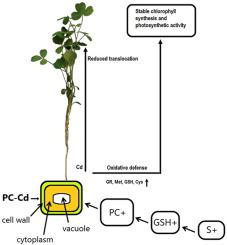Chemosphere ( IF 8.1 ) Pub Date : 2020-09-17 , DOI: 10.1016/j.chemosphere.2020.128361 Urmi Das , Md Atikur Rahman , Esrat Jahan Ela , Ki-Won Lee , Ahmad Humayan Kabir

|
Although Cd is threatening to the environment, animal, and human, the eco-friendly approach to mitigate the Cd-toxicity in alfalfa was barely studied. Therefore, this study aims at elucidating the role of S, a crucial microelement, in alleviating Cd toxicity in alfalfa plants. Supplementation of alfalfa exposed to Cd with S reversed the detrimental effect on plant biomass, chlorophyll synthesis, and protein concentration. Interestingly, S surplus restored the photosynthesis kinetics, such as Fv/Fm, Pi_ABS, and Mo values in leaves in response to Cd stress. Further, Cd-induced adverse effect on membrane stability, cell viability, and redox status was restored due to S under Cd stress. The exogenous S not only increased S status and the expression of sulfate transporters (MsSULRT1;2 and MsSULTR1;3), but also decreased the Cd concentration in the shoot by retaining elevated Cd in root tissue. Further analysis revealed the upregulation of MsGS (glutathione synthetase) and MsPCS1 (phytochelatin synthase) genes along with the increased concentration of glutathione and phytochelatin, predominantly in roots subjected to S surplus under Cd stress. The subcellular analysis further reveals that Cd binds to the cell wall rather than stored in vacuole, suggesting that S-induced elevated glutathione enables the phytochelatin to bind with excess Cd leading to subcellular sequestration in roots of alfalfa. Also, S stimulates the S-metabolites and GR enzyme that coordinately counteracts Cd-induced oxidative damage. These findings can be utilized to popularize the application of S and to perform breeding/transgenic experiments to develop Cd-free forage crops.
中文翻译:

硫触发谷胱甘肽和植物螯合素的积累,导致过量的镉结合在根的细胞壁上,从而减轻苜蓿的镉毒性
尽管Cd威胁着环境,动物和人类,但几乎没有研究减轻苜蓿中Cd毒性的环保方法。因此,本研究旨在阐明关键的微量元素S在减轻苜蓿植物中Cd毒性方面的作用。补充镉的紫花苜蓿对S的逆转对植物生物量,叶绿素合成和蛋白质浓度的有害影响。有趣的是,S剩余量可响应Cd胁迫恢复叶片的光合作用动力学,例如Fv / Fm,Pi_ABS和Mo值。此外,由于Cd胁迫下的S,恢复了Cd对膜稳定性,细胞活力和氧化还原状态的不利影响。外源性S不仅增加S状态和硫酸盐转运蛋白(MsSULRT1; 2和MsSULTR1; 3),但还可以通过在根部组织中保留升高的Cd来降低枝条中的Cd浓度。进一步分析显示MsGS(谷胱甘肽合成酶)和MsPCS1的上调(植物螯合素合酶)基因与谷胱甘肽和植物螯合素浓度的增加,主要存在于镉胁迫下过剩的根中。亚细胞分析进一步揭示了Cd与细胞壁结合而不是在液泡中存储,这表明S诱导的谷胱甘肽升高使植物螯合蛋白与过量的Cd结合,从而导致苜蓿根部的亚细胞螯合。此外,S刺激S-代谢物和GR酶,它们协调抵消Cd诱导的氧化损伤。这些发现可用于推广S的应用并进行育种/转基因实验,以开发无Cd饲料作物。











































 京公网安备 11010802027423号
京公网安备 11010802027423号